COIT20250 E-Business Systems: E-commerce Strategies & Advertising
VerifiedAdded on 2023/06/07
|14
|4226
|477
Portfolio
AI Summary
This portfolio explores key aspects of e-business systems, focusing on building an e-commerce presence, ensuring security, and implementing effective marketing strategies. It covers topics such as defining target audiences, conducting SWOT analyses, and understanding e-commerce security dimensions like integrity, authenticity, and confidentiality. Various e-commerce payment systems, including credit cards, debit cards, and net banking, are examined, along with strategies for enhancing e-commerce search usability, personalizing home pages, and optimizing shopping cart functionality. The importance of social media and customer feedback in driving e-commerce success is also highlighted. Furthermore, the portfolio delves into e-commerce marketing and advertising, covering pay-per-click advertising, search engine marketing, and the use of both online and offline channels to drive traffic to online stores. This document is available on Desklib, a platform offering a wide range of study resources and solved assignments for students.
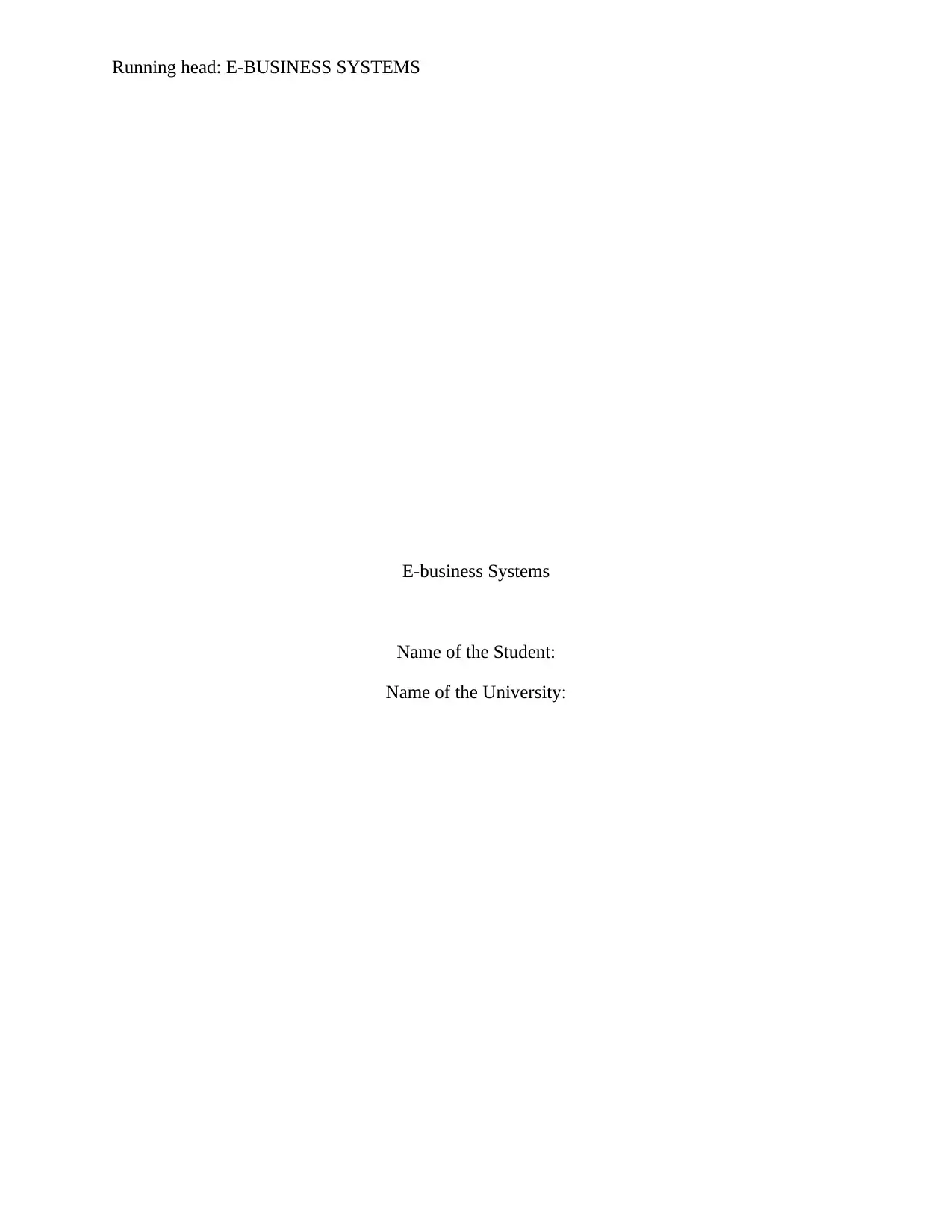
Running head: E-BUSINESS SYSTEMS
E-business Systems
Name of the Student:
Name of the University:
E-business Systems
Name of the Student:
Name of the University:
Paraphrase This Document
Need a fresh take? Get an instant paraphrase of this document with our AI Paraphraser
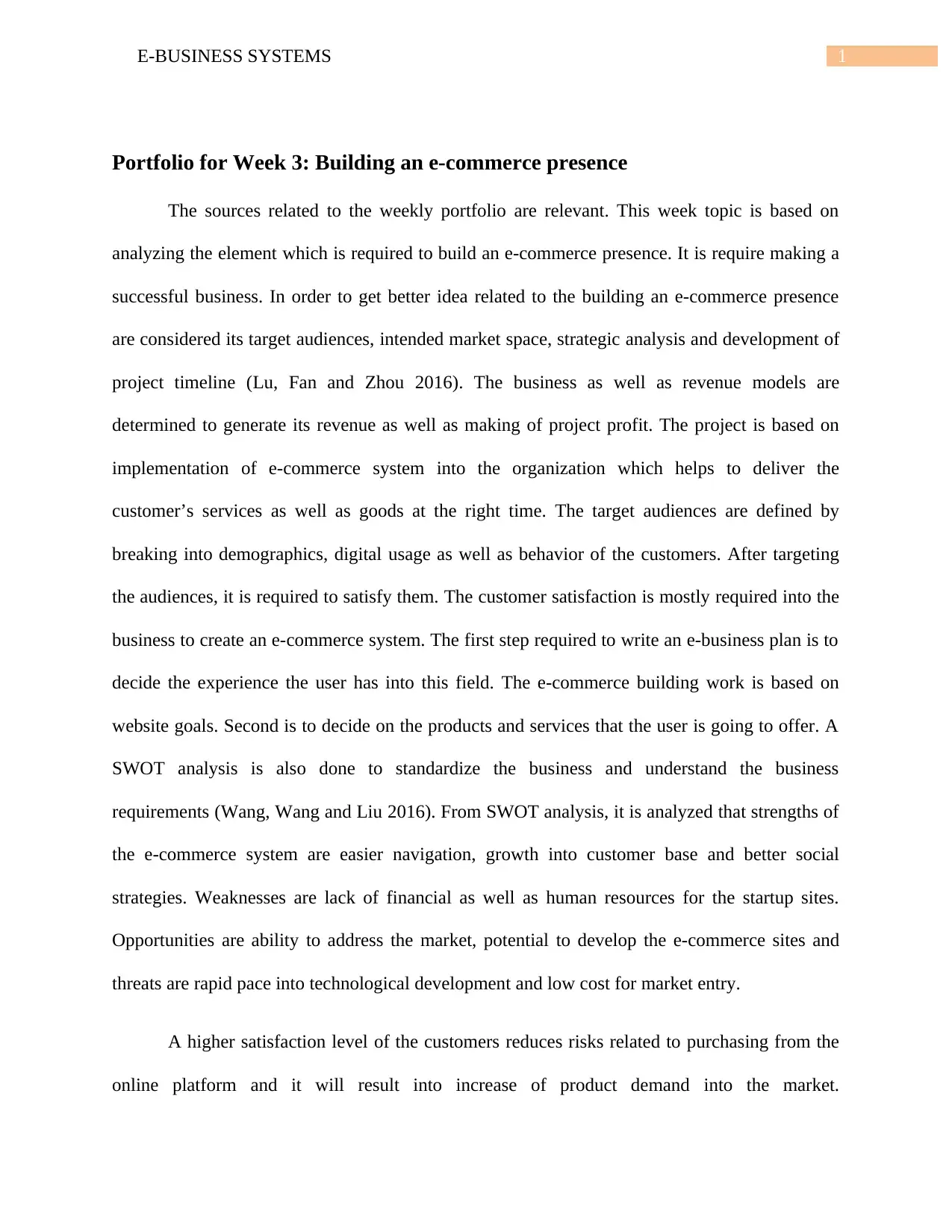
1E-BUSINESS SYSTEMS
Portfolio for Week 3: Building an e-commerce presence
The sources related to the weekly portfolio are relevant. This week topic is based on
analyzing the element which is required to build an e-commerce presence. It is require making a
successful business. In order to get better idea related to the building an e-commerce presence
are considered its target audiences, intended market space, strategic analysis and development of
project timeline (Lu, Fan and Zhou 2016). The business as well as revenue models are
determined to generate its revenue as well as making of project profit. The project is based on
implementation of e-commerce system into the organization which helps to deliver the
customer’s services as well as goods at the right time. The target audiences are defined by
breaking into demographics, digital usage as well as behavior of the customers. After targeting
the audiences, it is required to satisfy them. The customer satisfaction is mostly required into the
business to create an e-commerce system. The first step required to write an e-business plan is to
decide the experience the user has into this field. The e-commerce building work is based on
website goals. Second is to decide on the products and services that the user is going to offer. A
SWOT analysis is also done to standardize the business and understand the business
requirements (Wang, Wang and Liu 2016). From SWOT analysis, it is analyzed that strengths of
the e-commerce system are easier navigation, growth into customer base and better social
strategies. Weaknesses are lack of financial as well as human resources for the startup sites.
Opportunities are ability to address the market, potential to develop the e-commerce sites and
threats are rapid pace into technological development and low cost for market entry.
A higher satisfaction level of the customers reduces risks related to purchasing from the
online platform and it will result into increase of product demand into the market.
Portfolio for Week 3: Building an e-commerce presence
The sources related to the weekly portfolio are relevant. This week topic is based on
analyzing the element which is required to build an e-commerce presence. It is require making a
successful business. In order to get better idea related to the building an e-commerce presence
are considered its target audiences, intended market space, strategic analysis and development of
project timeline (Lu, Fan and Zhou 2016). The business as well as revenue models are
determined to generate its revenue as well as making of project profit. The project is based on
implementation of e-commerce system into the organization which helps to deliver the
customer’s services as well as goods at the right time. The target audiences are defined by
breaking into demographics, digital usage as well as behavior of the customers. After targeting
the audiences, it is required to satisfy them. The customer satisfaction is mostly required into the
business to create an e-commerce system. The first step required to write an e-business plan is to
decide the experience the user has into this field. The e-commerce building work is based on
website goals. Second is to decide on the products and services that the user is going to offer. A
SWOT analysis is also done to standardize the business and understand the business
requirements (Wang, Wang and Liu 2016). From SWOT analysis, it is analyzed that strengths of
the e-commerce system are easier navigation, growth into customer base and better social
strategies. Weaknesses are lack of financial as well as human resources for the startup sites.
Opportunities are ability to address the market, potential to develop the e-commerce sites and
threats are rapid pace into technological development and low cost for market entry.
A higher satisfaction level of the customers reduces risks related to purchasing from the
online platform and it will result into increase of product demand into the market.
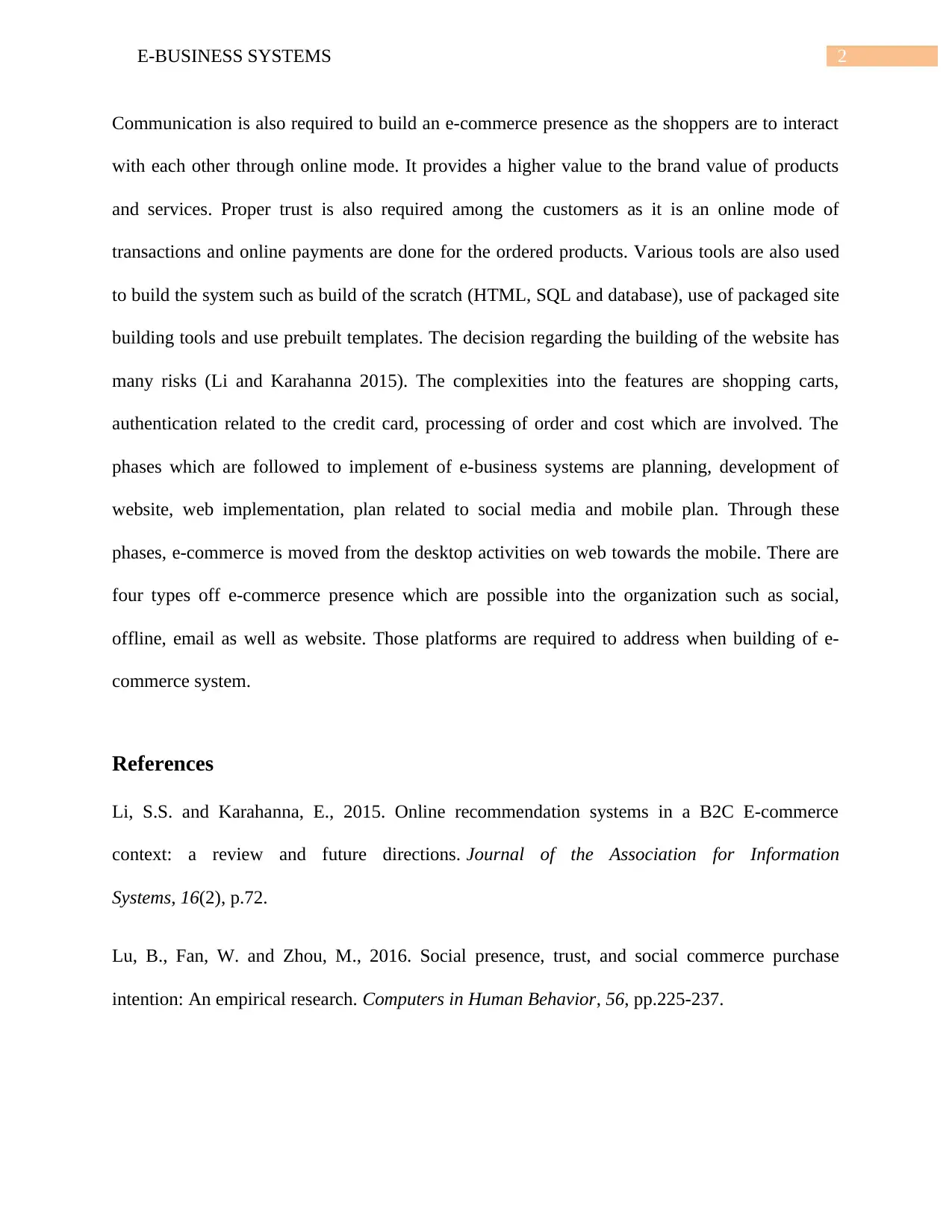
2E-BUSINESS SYSTEMS
Communication is also required to build an e-commerce presence as the shoppers are to interact
with each other through online mode. It provides a higher value to the brand value of products
and services. Proper trust is also required among the customers as it is an online mode of
transactions and online payments are done for the ordered products. Various tools are also used
to build the system such as build of the scratch (HTML, SQL and database), use of packaged site
building tools and use prebuilt templates. The decision regarding the building of the website has
many risks (Li and Karahanna 2015). The complexities into the features are shopping carts,
authentication related to the credit card, processing of order and cost which are involved. The
phases which are followed to implement of e-business systems are planning, development of
website, web implementation, plan related to social media and mobile plan. Through these
phases, e-commerce is moved from the desktop activities on web towards the mobile. There are
four types off e-commerce presence which are possible into the organization such as social,
offline, email as well as website. Those platforms are required to address when building of e-
commerce system.
References
Li, S.S. and Karahanna, E., 2015. Online recommendation systems in a B2C E-commerce
context: a review and future directions. Journal of the Association for Information
Systems, 16(2), p.72.
Lu, B., Fan, W. and Zhou, M., 2016. Social presence, trust, and social commerce purchase
intention: An empirical research. Computers in Human Behavior, 56, pp.225-237.
Communication is also required to build an e-commerce presence as the shoppers are to interact
with each other through online mode. It provides a higher value to the brand value of products
and services. Proper trust is also required among the customers as it is an online mode of
transactions and online payments are done for the ordered products. Various tools are also used
to build the system such as build of the scratch (HTML, SQL and database), use of packaged site
building tools and use prebuilt templates. The decision regarding the building of the website has
many risks (Li and Karahanna 2015). The complexities into the features are shopping carts,
authentication related to the credit card, processing of order and cost which are involved. The
phases which are followed to implement of e-business systems are planning, development of
website, web implementation, plan related to social media and mobile plan. Through these
phases, e-commerce is moved from the desktop activities on web towards the mobile. There are
four types off e-commerce presence which are possible into the organization such as social,
offline, email as well as website. Those platforms are required to address when building of e-
commerce system.
References
Li, S.S. and Karahanna, E., 2015. Online recommendation systems in a B2C E-commerce
context: a review and future directions. Journal of the Association for Information
Systems, 16(2), p.72.
Lu, B., Fan, W. and Zhou, M., 2016. Social presence, trust, and social commerce purchase
intention: An empirical research. Computers in Human Behavior, 56, pp.225-237.
⊘ This is a preview!⊘
Do you want full access?
Subscribe today to unlock all pages.

Trusted by 1+ million students worldwide
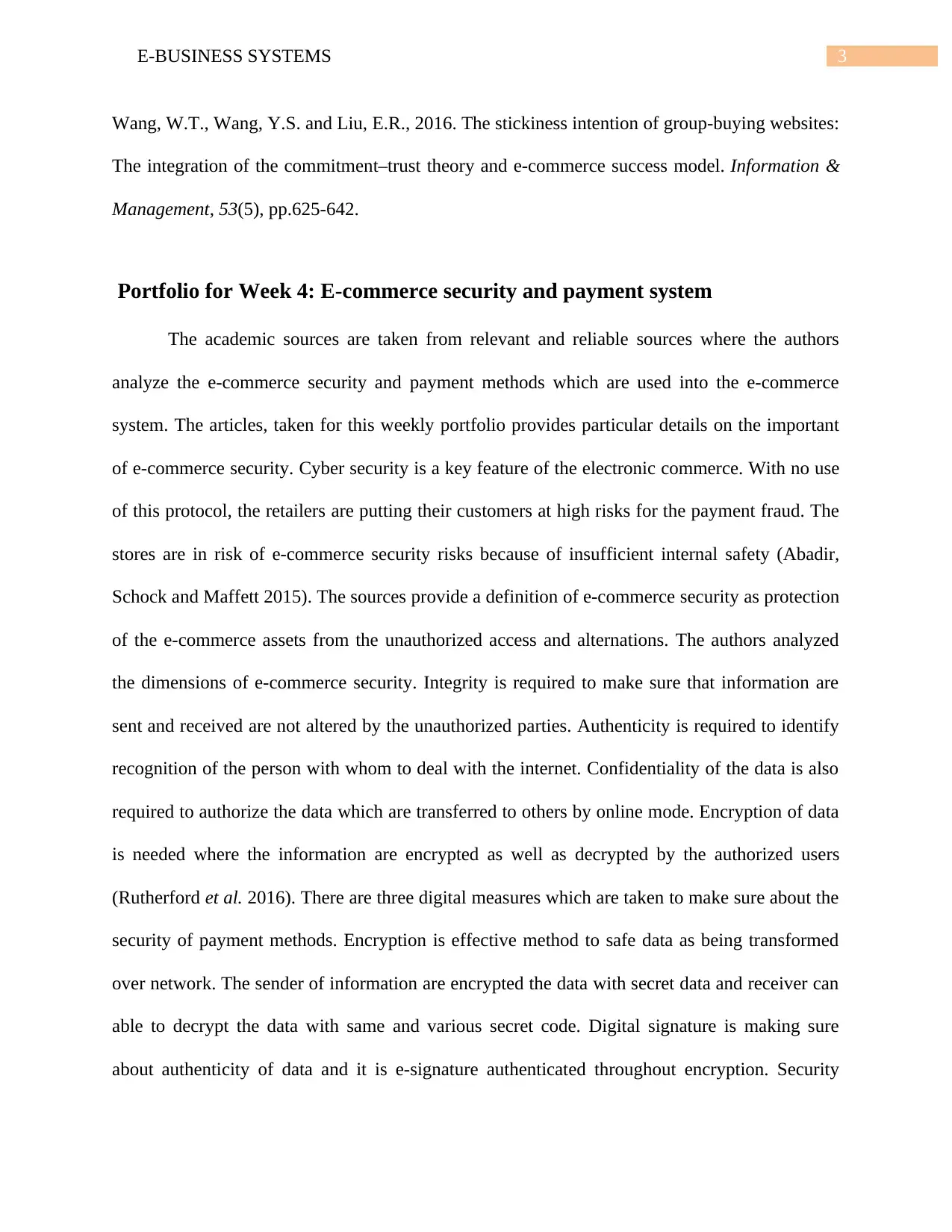
3E-BUSINESS SYSTEMS
Wang, W.T., Wang, Y.S. and Liu, E.R., 2016. The stickiness intention of group-buying websites:
The integration of the commitment–trust theory and e-commerce success model. Information &
Management, 53(5), pp.625-642.
Portfolio for Week 4: E-commerce security and payment system
The academic sources are taken from relevant and reliable sources where the authors
analyze the e-commerce security and payment methods which are used into the e-commerce
system. The articles, taken for this weekly portfolio provides particular details on the important
of e-commerce security. Cyber security is a key feature of the electronic commerce. With no use
of this protocol, the retailers are putting their customers at high risks for the payment fraud. The
stores are in risk of e-commerce security risks because of insufficient internal safety (Abadir,
Schock and Maffett 2015). The sources provide a definition of e-commerce security as protection
of the e-commerce assets from the unauthorized access and alternations. The authors analyzed
the dimensions of e-commerce security. Integrity is required to make sure that information are
sent and received are not altered by the unauthorized parties. Authenticity is required to identify
recognition of the person with whom to deal with the internet. Confidentiality of the data is also
required to authorize the data which are transferred to others by online mode. Encryption of data
is needed where the information are encrypted as well as decrypted by the authorized users
(Rutherford et al. 2016). There are three digital measures which are taken to make sure about the
security of payment methods. Encryption is effective method to safe data as being transformed
over network. The sender of information are encrypted the data with secret data and receiver can
able to decrypt the data with same and various secret code. Digital signature is making sure
about authenticity of data and it is e-signature authenticated throughout encryption. Security
Wang, W.T., Wang, Y.S. and Liu, E.R., 2016. The stickiness intention of group-buying websites:
The integration of the commitment–trust theory and e-commerce success model. Information &
Management, 53(5), pp.625-642.
Portfolio for Week 4: E-commerce security and payment system
The academic sources are taken from relevant and reliable sources where the authors
analyze the e-commerce security and payment methods which are used into the e-commerce
system. The articles, taken for this weekly portfolio provides particular details on the important
of e-commerce security. Cyber security is a key feature of the electronic commerce. With no use
of this protocol, the retailers are putting their customers at high risks for the payment fraud. The
stores are in risk of e-commerce security risks because of insufficient internal safety (Abadir,
Schock and Maffett 2015). The sources provide a definition of e-commerce security as protection
of the e-commerce assets from the unauthorized access and alternations. The authors analyzed
the dimensions of e-commerce security. Integrity is required to make sure that information are
sent and received are not altered by the unauthorized parties. Authenticity is required to identify
recognition of the person with whom to deal with the internet. Confidentiality of the data is also
required to authorize the data which are transferred to others by online mode. Encryption of data
is needed where the information are encrypted as well as decrypted by the authorized users
(Rutherford et al. 2016). There are three digital measures which are taken to make sure about the
security of payment methods. Encryption is effective method to safe data as being transformed
over network. The sender of information are encrypted the data with secret data and receiver can
able to decrypt the data with same and various secret code. Digital signature is making sure
about authenticity of data and it is e-signature authenticated throughout encryption. Security
Paraphrase This Document
Need a fresh take? Get an instant paraphrase of this document with our AI Paraphraser
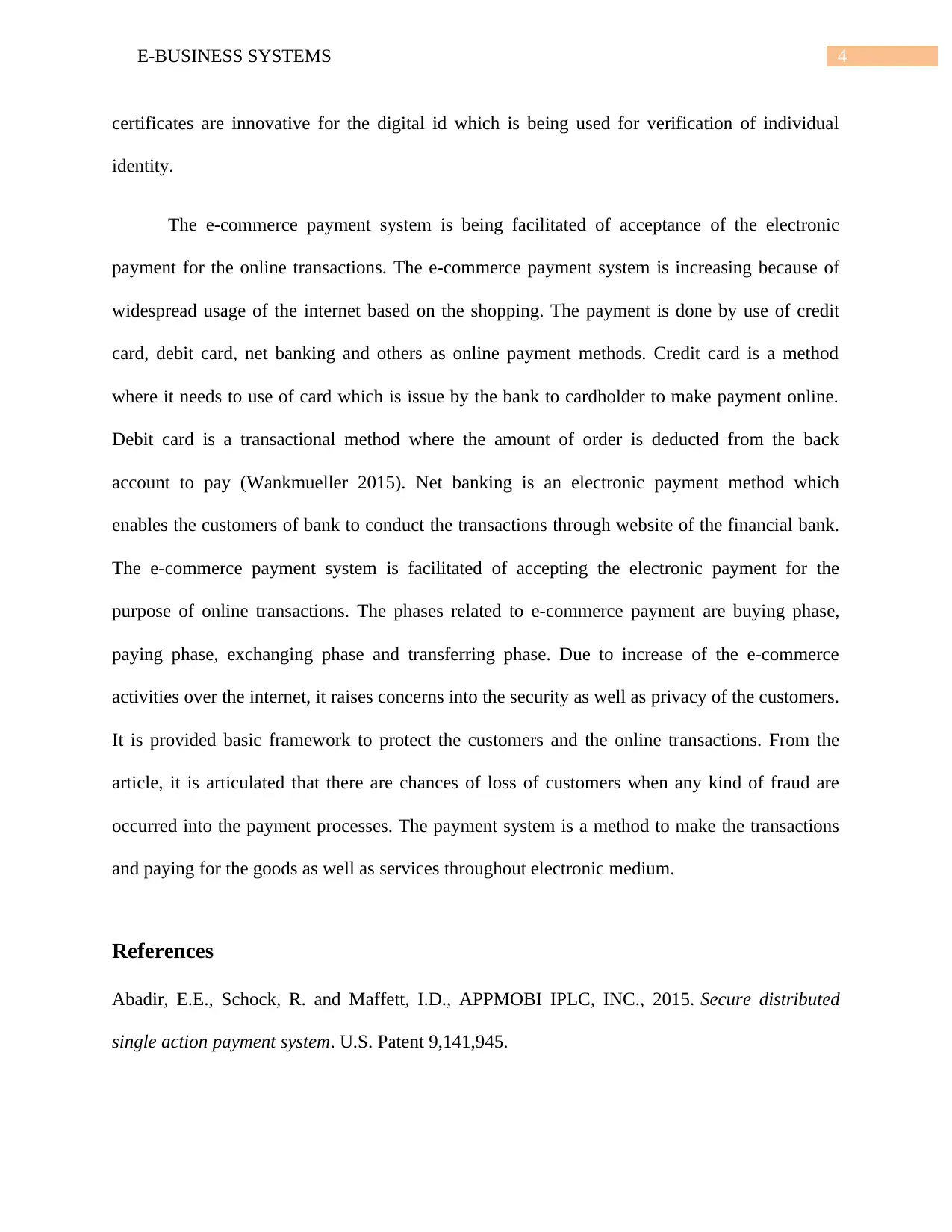
4E-BUSINESS SYSTEMS
certificates are innovative for the digital id which is being used for verification of individual
identity.
The e-commerce payment system is being facilitated of acceptance of the electronic
payment for the online transactions. The e-commerce payment system is increasing because of
widespread usage of the internet based on the shopping. The payment is done by use of credit
card, debit card, net banking and others as online payment methods. Credit card is a method
where it needs to use of card which is issue by the bank to cardholder to make payment online.
Debit card is a transactional method where the amount of order is deducted from the back
account to pay (Wankmueller 2015). Net banking is an electronic payment method which
enables the customers of bank to conduct the transactions through website of the financial bank.
The e-commerce payment system is facilitated of accepting the electronic payment for the
purpose of online transactions. The phases related to e-commerce payment are buying phase,
paying phase, exchanging phase and transferring phase. Due to increase of the e-commerce
activities over the internet, it raises concerns into the security as well as privacy of the customers.
It is provided basic framework to protect the customers and the online transactions. From the
article, it is articulated that there are chances of loss of customers when any kind of fraud are
occurred into the payment processes. The payment system is a method to make the transactions
and paying for the goods as well as services throughout electronic medium.
References
Abadir, E.E., Schock, R. and Maffett, I.D., APPMOBI IPLC, INC., 2015. Secure distributed
single action payment system. U.S. Patent 9,141,945.
certificates are innovative for the digital id which is being used for verification of individual
identity.
The e-commerce payment system is being facilitated of acceptance of the electronic
payment for the online transactions. The e-commerce payment system is increasing because of
widespread usage of the internet based on the shopping. The payment is done by use of credit
card, debit card, net banking and others as online payment methods. Credit card is a method
where it needs to use of card which is issue by the bank to cardholder to make payment online.
Debit card is a transactional method where the amount of order is deducted from the back
account to pay (Wankmueller 2015). Net banking is an electronic payment method which
enables the customers of bank to conduct the transactions through website of the financial bank.
The e-commerce payment system is facilitated of accepting the electronic payment for the
purpose of online transactions. The phases related to e-commerce payment are buying phase,
paying phase, exchanging phase and transferring phase. Due to increase of the e-commerce
activities over the internet, it raises concerns into the security as well as privacy of the customers.
It is provided basic framework to protect the customers and the online transactions. From the
article, it is articulated that there are chances of loss of customers when any kind of fraud are
occurred into the payment processes. The payment system is a method to make the transactions
and paying for the goods as well as services throughout electronic medium.
References
Abadir, E.E., Schock, R. and Maffett, I.D., APPMOBI IPLC, INC., 2015. Secure distributed
single action payment system. U.S. Patent 9,141,945.
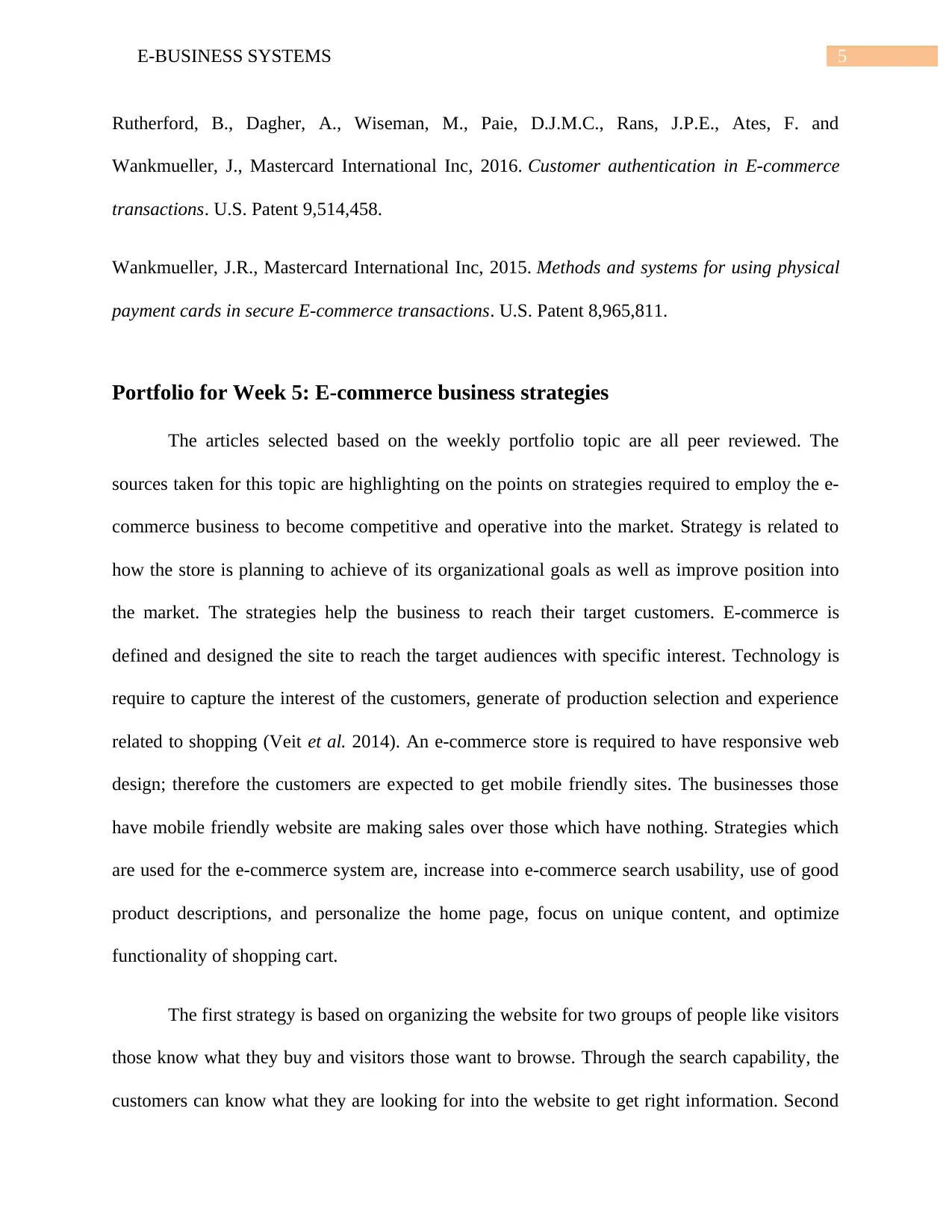
5E-BUSINESS SYSTEMS
Rutherford, B., Dagher, A., Wiseman, M., Paie, D.J.M.C., Rans, J.P.E., Ates, F. and
Wankmueller, J., Mastercard International Inc, 2016. Customer authentication in E-commerce
transactions. U.S. Patent 9,514,458.
Wankmueller, J.R., Mastercard International Inc, 2015. Methods and systems for using physical
payment cards in secure E-commerce transactions. U.S. Patent 8,965,811.
Portfolio for Week 5: E-commerce business strategies
The articles selected based on the weekly portfolio topic are all peer reviewed. The
sources taken for this topic are highlighting on the points on strategies required to employ the e-
commerce business to become competitive and operative into the market. Strategy is related to
how the store is planning to achieve of its organizational goals as well as improve position into
the market. The strategies help the business to reach their target customers. E-commerce is
defined and designed the site to reach the target audiences with specific interest. Technology is
require to capture the interest of the customers, generate of production selection and experience
related to shopping (Veit et al. 2014). An e-commerce store is required to have responsive web
design; therefore the customers are expected to get mobile friendly sites. The businesses those
have mobile friendly website are making sales over those which have nothing. Strategies which
are used for the e-commerce system are, increase into e-commerce search usability, use of good
product descriptions, and personalize the home page, focus on unique content, and optimize
functionality of shopping cart.
The first strategy is based on organizing the website for two groups of people like visitors
those know what they buy and visitors those want to browse. Through the search capability, the
customers can know what they are looking for into the website to get right information. Second
Rutherford, B., Dagher, A., Wiseman, M., Paie, D.J.M.C., Rans, J.P.E., Ates, F. and
Wankmueller, J., Mastercard International Inc, 2016. Customer authentication in E-commerce
transactions. U.S. Patent 9,514,458.
Wankmueller, J.R., Mastercard International Inc, 2015. Methods and systems for using physical
payment cards in secure E-commerce transactions. U.S. Patent 8,965,811.
Portfolio for Week 5: E-commerce business strategies
The articles selected based on the weekly portfolio topic are all peer reviewed. The
sources taken for this topic are highlighting on the points on strategies required to employ the e-
commerce business to become competitive and operative into the market. Strategy is related to
how the store is planning to achieve of its organizational goals as well as improve position into
the market. The strategies help the business to reach their target customers. E-commerce is
defined and designed the site to reach the target audiences with specific interest. Technology is
require to capture the interest of the customers, generate of production selection and experience
related to shopping (Veit et al. 2014). An e-commerce store is required to have responsive web
design; therefore the customers are expected to get mobile friendly sites. The businesses those
have mobile friendly website are making sales over those which have nothing. Strategies which
are used for the e-commerce system are, increase into e-commerce search usability, use of good
product descriptions, and personalize the home page, focus on unique content, and optimize
functionality of shopping cart.
The first strategy is based on organizing the website for two groups of people like visitors
those know what they buy and visitors those want to browse. Through the search capability, the
customers can know what they are looking for into the website to get right information. Second
⊘ This is a preview!⊘
Do you want full access?
Subscribe today to unlock all pages.

Trusted by 1+ million students worldwide
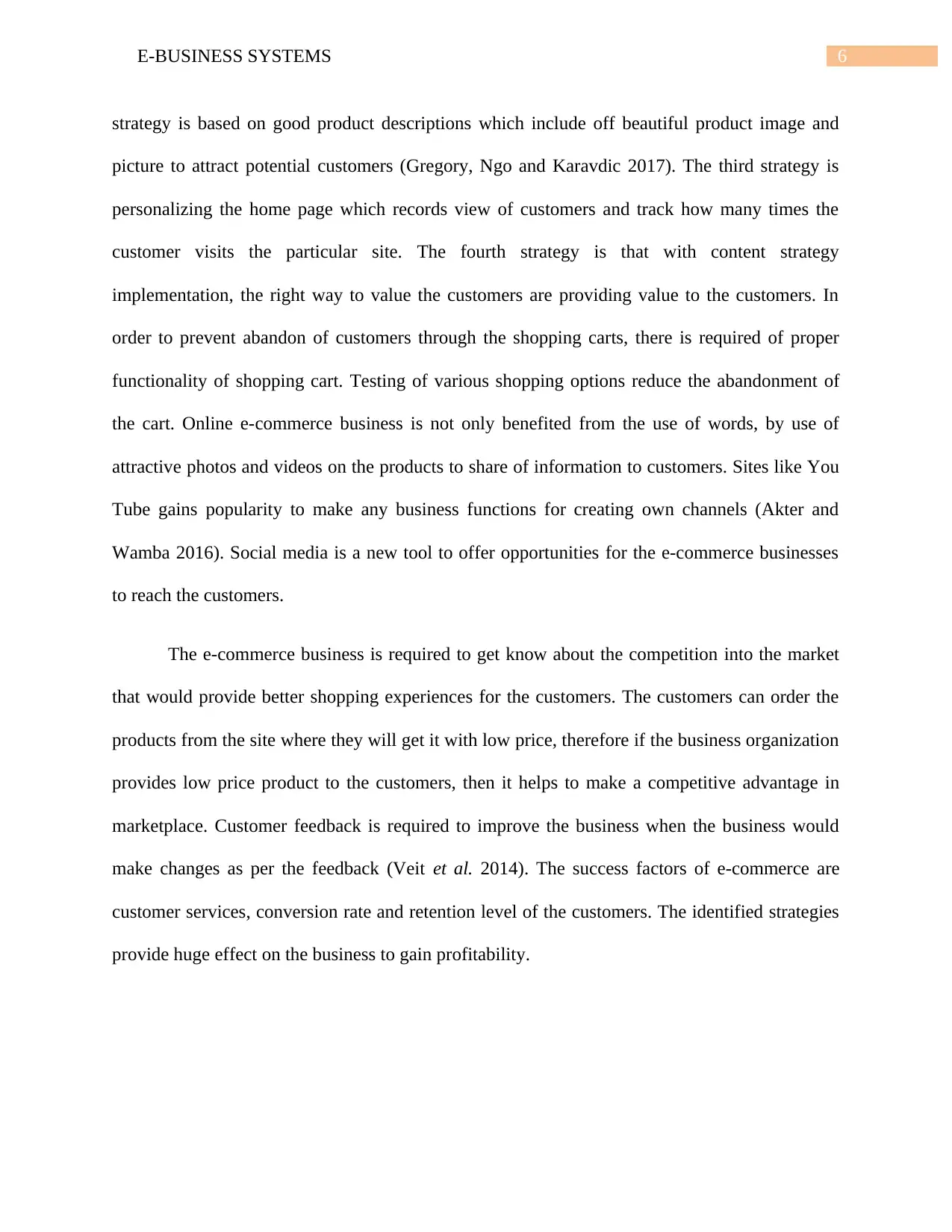
6E-BUSINESS SYSTEMS
strategy is based on good product descriptions which include off beautiful product image and
picture to attract potential customers (Gregory, Ngo and Karavdic 2017). The third strategy is
personalizing the home page which records view of customers and track how many times the
customer visits the particular site. The fourth strategy is that with content strategy
implementation, the right way to value the customers are providing value to the customers. In
order to prevent abandon of customers through the shopping carts, there is required of proper
functionality of shopping cart. Testing of various shopping options reduce the abandonment of
the cart. Online e-commerce business is not only benefited from the use of words, by use of
attractive photos and videos on the products to share of information to customers. Sites like You
Tube gains popularity to make any business functions for creating own channels (Akter and
Wamba 2016). Social media is a new tool to offer opportunities for the e-commerce businesses
to reach the customers.
The e-commerce business is required to get know about the competition into the market
that would provide better shopping experiences for the customers. The customers can order the
products from the site where they will get it with low price, therefore if the business organization
provides low price product to the customers, then it helps to make a competitive advantage in
marketplace. Customer feedback is required to improve the business when the business would
make changes as per the feedback (Veit et al. 2014). The success factors of e-commerce are
customer services, conversion rate and retention level of the customers. The identified strategies
provide huge effect on the business to gain profitability.
strategy is based on good product descriptions which include off beautiful product image and
picture to attract potential customers (Gregory, Ngo and Karavdic 2017). The third strategy is
personalizing the home page which records view of customers and track how many times the
customer visits the particular site. The fourth strategy is that with content strategy
implementation, the right way to value the customers are providing value to the customers. In
order to prevent abandon of customers through the shopping carts, there is required of proper
functionality of shopping cart. Testing of various shopping options reduce the abandonment of
the cart. Online e-commerce business is not only benefited from the use of words, by use of
attractive photos and videos on the products to share of information to customers. Sites like You
Tube gains popularity to make any business functions for creating own channels (Akter and
Wamba 2016). Social media is a new tool to offer opportunities for the e-commerce businesses
to reach the customers.
The e-commerce business is required to get know about the competition into the market
that would provide better shopping experiences for the customers. The customers can order the
products from the site where they will get it with low price, therefore if the business organization
provides low price product to the customers, then it helps to make a competitive advantage in
marketplace. Customer feedback is required to improve the business when the business would
make changes as per the feedback (Veit et al. 2014). The success factors of e-commerce are
customer services, conversion rate and retention level of the customers. The identified strategies
provide huge effect on the business to gain profitability.
Paraphrase This Document
Need a fresh take? Get an instant paraphrase of this document with our AI Paraphraser
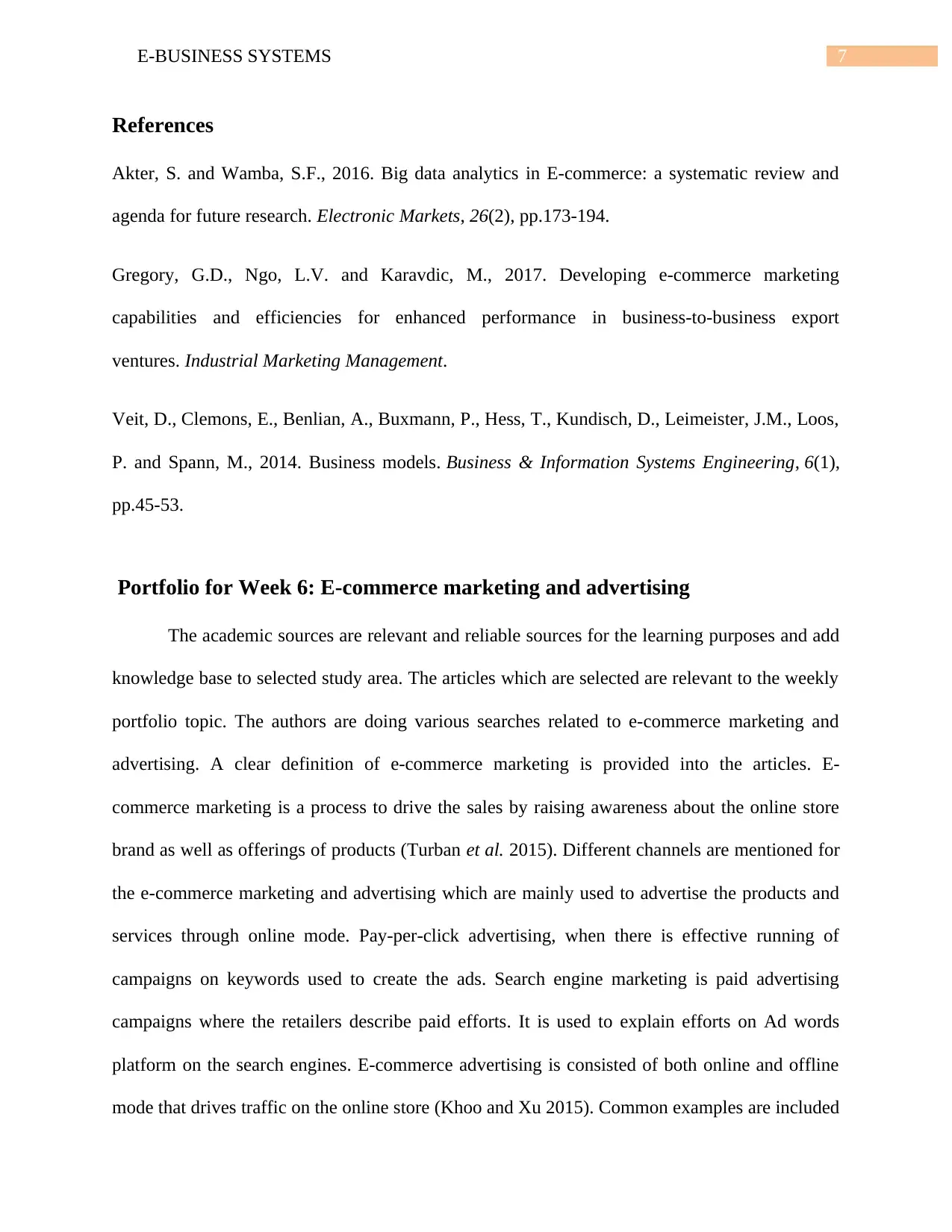
7E-BUSINESS SYSTEMS
References
Akter, S. and Wamba, S.F., 2016. Big data analytics in E-commerce: a systematic review and
agenda for future research. Electronic Markets, 26(2), pp.173-194.
Gregory, G.D., Ngo, L.V. and Karavdic, M., 2017. Developing e-commerce marketing
capabilities and efficiencies for enhanced performance in business-to-business export
ventures. Industrial Marketing Management.
Veit, D., Clemons, E., Benlian, A., Buxmann, P., Hess, T., Kundisch, D., Leimeister, J.M., Loos,
P. and Spann, M., 2014. Business models. Business & Information Systems Engineering, 6(1),
pp.45-53.
Portfolio for Week 6: E-commerce marketing and advertising
The academic sources are relevant and reliable sources for the learning purposes and add
knowledge base to selected study area. The articles which are selected are relevant to the weekly
portfolio topic. The authors are doing various searches related to e-commerce marketing and
advertising. A clear definition of e-commerce marketing is provided into the articles. E-
commerce marketing is a process to drive the sales by raising awareness about the online store
brand as well as offerings of products (Turban et al. 2015). Different channels are mentioned for
the e-commerce marketing and advertising which are mainly used to advertise the products and
services through online mode. Pay-per-click advertising, when there is effective running of
campaigns on keywords used to create the ads. Search engine marketing is paid advertising
campaigns where the retailers describe paid efforts. It is used to explain efforts on Ad words
platform on the search engines. E-commerce advertising is consisted of both online and offline
mode that drives traffic on the online store (Khoo and Xu 2015). Common examples are included
References
Akter, S. and Wamba, S.F., 2016. Big data analytics in E-commerce: a systematic review and
agenda for future research. Electronic Markets, 26(2), pp.173-194.
Gregory, G.D., Ngo, L.V. and Karavdic, M., 2017. Developing e-commerce marketing
capabilities and efficiencies for enhanced performance in business-to-business export
ventures. Industrial Marketing Management.
Veit, D., Clemons, E., Benlian, A., Buxmann, P., Hess, T., Kundisch, D., Leimeister, J.M., Loos,
P. and Spann, M., 2014. Business models. Business & Information Systems Engineering, 6(1),
pp.45-53.
Portfolio for Week 6: E-commerce marketing and advertising
The academic sources are relevant and reliable sources for the learning purposes and add
knowledge base to selected study area. The articles which are selected are relevant to the weekly
portfolio topic. The authors are doing various searches related to e-commerce marketing and
advertising. A clear definition of e-commerce marketing is provided into the articles. E-
commerce marketing is a process to drive the sales by raising awareness about the online store
brand as well as offerings of products (Turban et al. 2015). Different channels are mentioned for
the e-commerce marketing and advertising which are mainly used to advertise the products and
services through online mode. Pay-per-click advertising, when there is effective running of
campaigns on keywords used to create the ads. Search engine marketing is paid advertising
campaigns where the retailers describe paid efforts. It is used to explain efforts on Ad words
platform on the search engines. E-commerce advertising is consisted of both online and offline
mode that drives traffic on the online store (Khoo and Xu 2015). Common examples are included
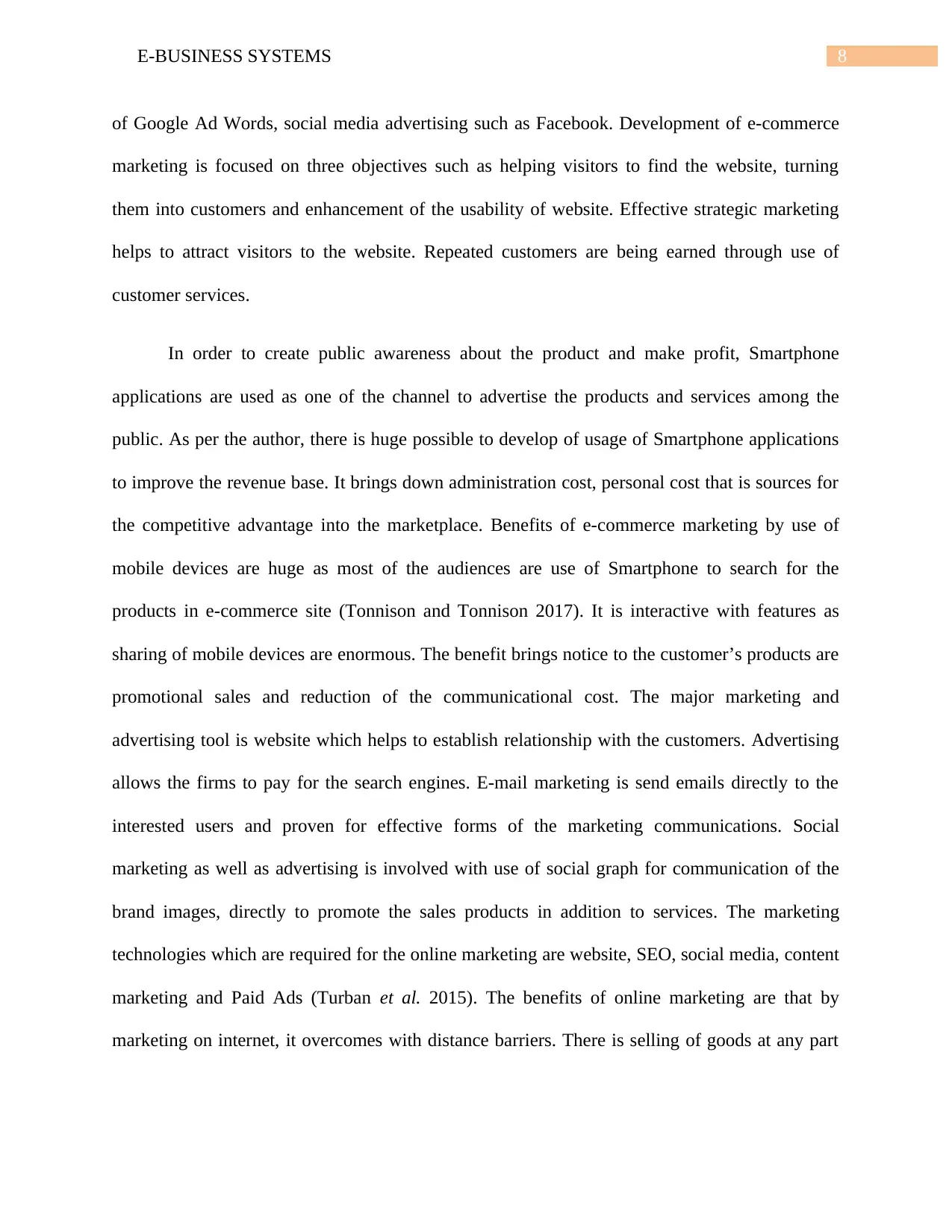
8E-BUSINESS SYSTEMS
of Google Ad Words, social media advertising such as Facebook. Development of e-commerce
marketing is focused on three objectives such as helping visitors to find the website, turning
them into customers and enhancement of the usability of website. Effective strategic marketing
helps to attract visitors to the website. Repeated customers are being earned through use of
customer services.
In order to create public awareness about the product and make profit, Smartphone
applications are used as one of the channel to advertise the products and services among the
public. As per the author, there is huge possible to develop of usage of Smartphone applications
to improve the revenue base. It brings down administration cost, personal cost that is sources for
the competitive advantage into the marketplace. Benefits of e-commerce marketing by use of
mobile devices are huge as most of the audiences are use of Smartphone to search for the
products in e-commerce site (Tonnison and Tonnison 2017). It is interactive with features as
sharing of mobile devices are enormous. The benefit brings notice to the customer’s products are
promotional sales and reduction of the communicational cost. The major marketing and
advertising tool is website which helps to establish relationship with the customers. Advertising
allows the firms to pay for the search engines. E-mail marketing is send emails directly to the
interested users and proven for effective forms of the marketing communications. Social
marketing as well as advertising is involved with use of social graph for communication of the
brand images, directly to promote the sales products in addition to services. The marketing
technologies which are required for the online marketing are website, SEO, social media, content
marketing and Paid Ads (Turban et al. 2015). The benefits of online marketing are that by
marketing on internet, it overcomes with distance barriers. There is selling of goods at any part
of Google Ad Words, social media advertising such as Facebook. Development of e-commerce
marketing is focused on three objectives such as helping visitors to find the website, turning
them into customers and enhancement of the usability of website. Effective strategic marketing
helps to attract visitors to the website. Repeated customers are being earned through use of
customer services.
In order to create public awareness about the product and make profit, Smartphone
applications are used as one of the channel to advertise the products and services among the
public. As per the author, there is huge possible to develop of usage of Smartphone applications
to improve the revenue base. It brings down administration cost, personal cost that is sources for
the competitive advantage into the marketplace. Benefits of e-commerce marketing by use of
mobile devices are huge as most of the audiences are use of Smartphone to search for the
products in e-commerce site (Tonnison and Tonnison 2017). It is interactive with features as
sharing of mobile devices are enormous. The benefit brings notice to the customer’s products are
promotional sales and reduction of the communicational cost. The major marketing and
advertising tool is website which helps to establish relationship with the customers. Advertising
allows the firms to pay for the search engines. E-mail marketing is send emails directly to the
interested users and proven for effective forms of the marketing communications. Social
marketing as well as advertising is involved with use of social graph for communication of the
brand images, directly to promote the sales products in addition to services. The marketing
technologies which are required for the online marketing are website, SEO, social media, content
marketing and Paid Ads (Turban et al. 2015). The benefits of online marketing are that by
marketing on internet, it overcomes with distance barriers. There is selling of goods at any part
⊘ This is a preview!⊘
Do you want full access?
Subscribe today to unlock all pages.

Trusted by 1+ million students worldwide
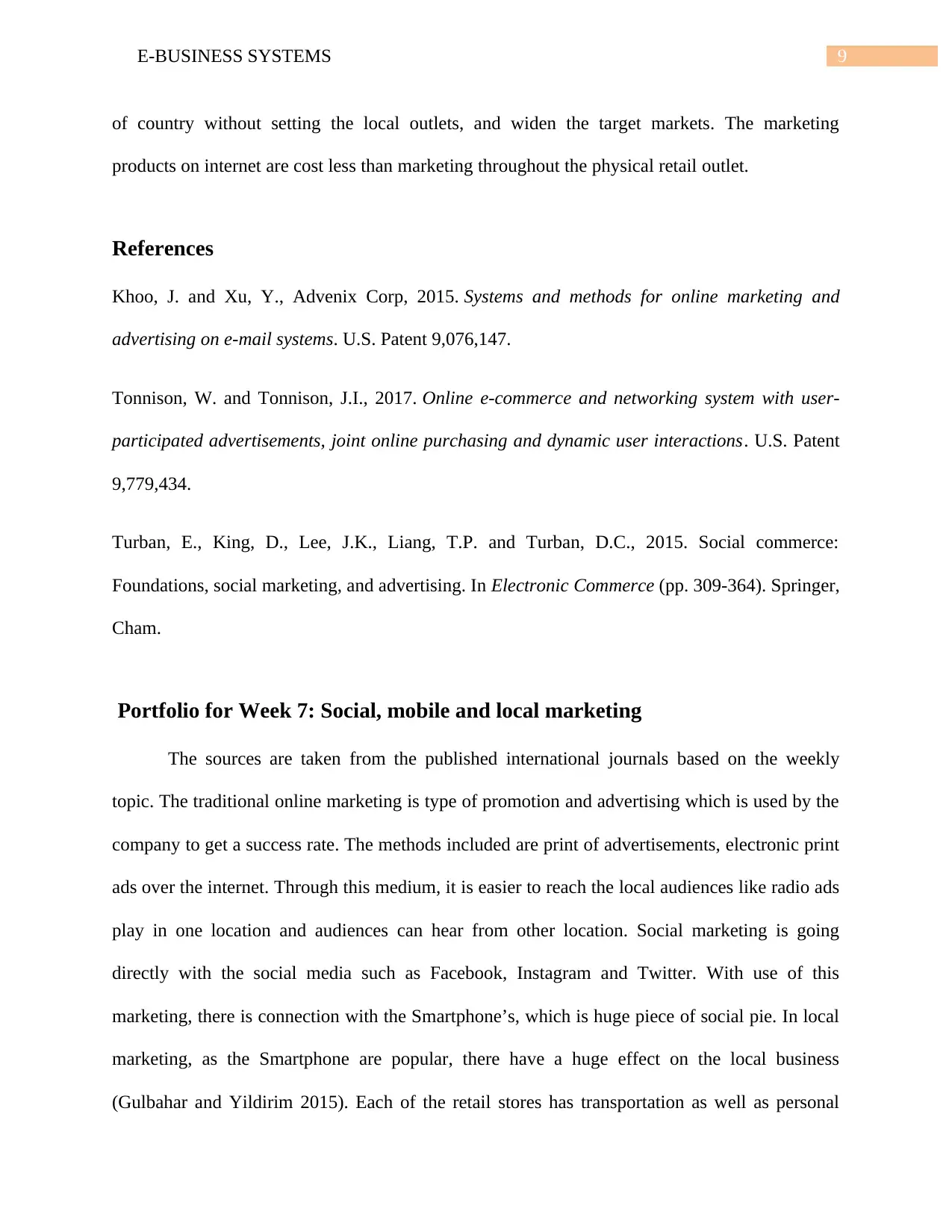
9E-BUSINESS SYSTEMS
of country without setting the local outlets, and widen the target markets. The marketing
products on internet are cost less than marketing throughout the physical retail outlet.
References
Khoo, J. and Xu, Y., Advenix Corp, 2015. Systems and methods for online marketing and
advertising on e-mail systems. U.S. Patent 9,076,147.
Tonnison, W. and Tonnison, J.I., 2017. Online e-commerce and networking system with user-
participated advertisements, joint online purchasing and dynamic user interactions. U.S. Patent
9,779,434.
Turban, E., King, D., Lee, J.K., Liang, T.P. and Turban, D.C., 2015. Social commerce:
Foundations, social marketing, and advertising. In Electronic Commerce (pp. 309-364). Springer,
Cham.
Portfolio for Week 7: Social, mobile and local marketing
The sources are taken from the published international journals based on the weekly
topic. The traditional online marketing is type of promotion and advertising which is used by the
company to get a success rate. The methods included are print of advertisements, electronic print
ads over the internet. Through this medium, it is easier to reach the local audiences like radio ads
play in one location and audiences can hear from other location. Social marketing is going
directly with the social media such as Facebook, Instagram and Twitter. With use of this
marketing, there is connection with the Smartphone’s, which is huge piece of social pie. In local
marketing, as the Smartphone are popular, there have a huge effect on the local business
(Gulbahar and Yildirim 2015). Each of the retail stores has transportation as well as personal
of country without setting the local outlets, and widen the target markets. The marketing
products on internet are cost less than marketing throughout the physical retail outlet.
References
Khoo, J. and Xu, Y., Advenix Corp, 2015. Systems and methods for online marketing and
advertising on e-mail systems. U.S. Patent 9,076,147.
Tonnison, W. and Tonnison, J.I., 2017. Online e-commerce and networking system with user-
participated advertisements, joint online purchasing and dynamic user interactions. U.S. Patent
9,779,434.
Turban, E., King, D., Lee, J.K., Liang, T.P. and Turban, D.C., 2015. Social commerce:
Foundations, social marketing, and advertising. In Electronic Commerce (pp. 309-364). Springer,
Cham.
Portfolio for Week 7: Social, mobile and local marketing
The sources are taken from the published international journals based on the weekly
topic. The traditional online marketing is type of promotion and advertising which is used by the
company to get a success rate. The methods included are print of advertisements, electronic print
ads over the internet. Through this medium, it is easier to reach the local audiences like radio ads
play in one location and audiences can hear from other location. Social marketing is going
directly with the social media such as Facebook, Instagram and Twitter. With use of this
marketing, there is connection with the Smartphone’s, which is huge piece of social pie. In local
marketing, as the Smartphone are popular, there have a huge effect on the local business
(Gulbahar and Yildirim 2015). Each of the retail stores has transportation as well as personal
Paraphrase This Document
Need a fresh take? Get an instant paraphrase of this document with our AI Paraphraser
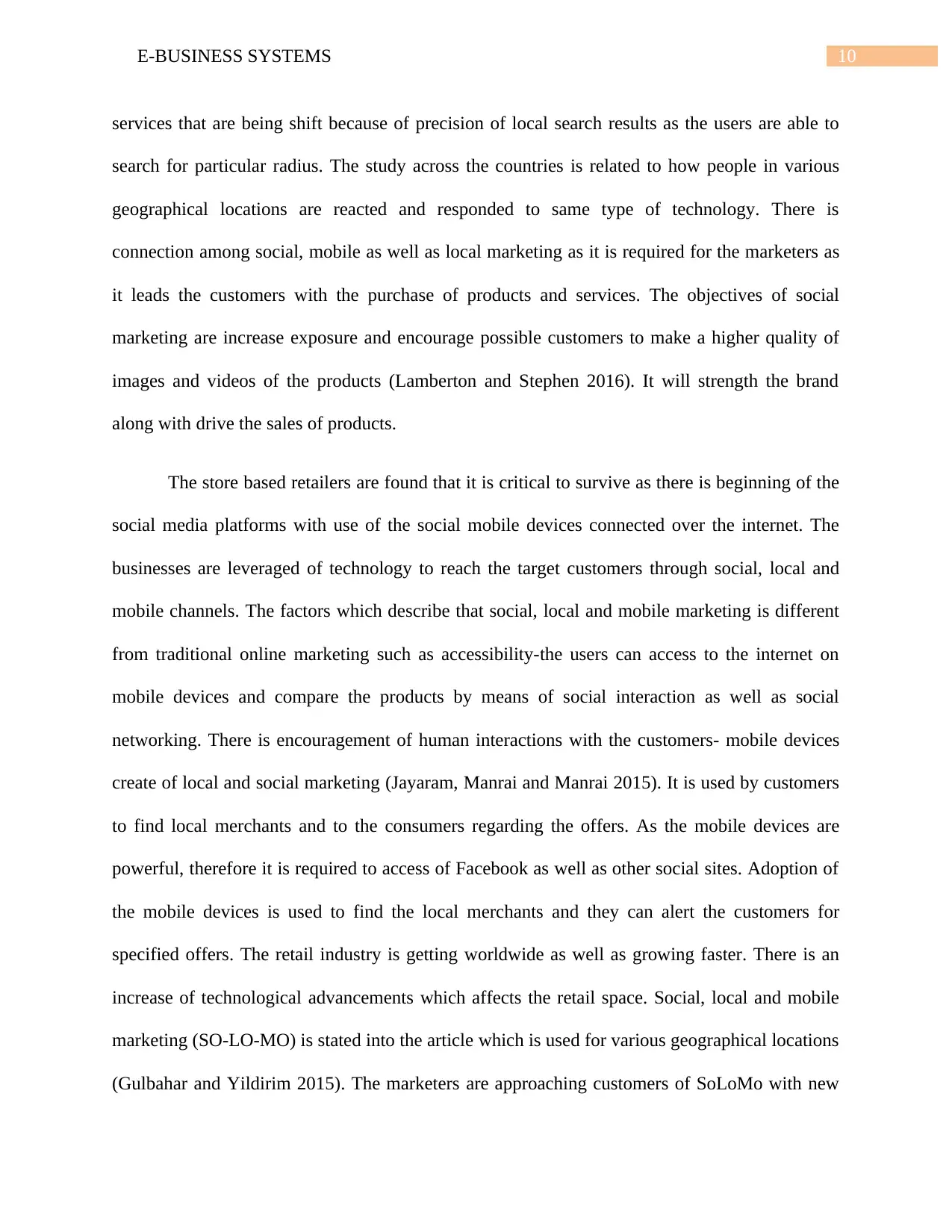
10E-BUSINESS SYSTEMS
services that are being shift because of precision of local search results as the users are able to
search for particular radius. The study across the countries is related to how people in various
geographical locations are reacted and responded to same type of technology. There is
connection among social, mobile as well as local marketing as it is required for the marketers as
it leads the customers with the purchase of products and services. The objectives of social
marketing are increase exposure and encourage possible customers to make a higher quality of
images and videos of the products (Lamberton and Stephen 2016). It will strength the brand
along with drive the sales of products.
The store based retailers are found that it is critical to survive as there is beginning of the
social media platforms with use of the social mobile devices connected over the internet. The
businesses are leveraged of technology to reach the target customers through social, local and
mobile channels. The factors which describe that social, local and mobile marketing is different
from traditional online marketing such as accessibility-the users can access to the internet on
mobile devices and compare the products by means of social interaction as well as social
networking. There is encouragement of human interactions with the customers- mobile devices
create of local and social marketing (Jayaram, Manrai and Manrai 2015). It is used by customers
to find local merchants and to the consumers regarding the offers. As the mobile devices are
powerful, therefore it is required to access of Facebook as well as other social sites. Adoption of
the mobile devices is used to find the local merchants and they can alert the customers for
specified offers. The retail industry is getting worldwide as well as growing faster. There is an
increase of technological advancements which affects the retail space. Social, local and mobile
marketing (SO-LO-MO) is stated into the article which is used for various geographical locations
(Gulbahar and Yildirim 2015). The marketers are approaching customers of SoLoMo with new
services that are being shift because of precision of local search results as the users are able to
search for particular radius. The study across the countries is related to how people in various
geographical locations are reacted and responded to same type of technology. There is
connection among social, mobile as well as local marketing as it is required for the marketers as
it leads the customers with the purchase of products and services. The objectives of social
marketing are increase exposure and encourage possible customers to make a higher quality of
images and videos of the products (Lamberton and Stephen 2016). It will strength the brand
along with drive the sales of products.
The store based retailers are found that it is critical to survive as there is beginning of the
social media platforms with use of the social mobile devices connected over the internet. The
businesses are leveraged of technology to reach the target customers through social, local and
mobile channels. The factors which describe that social, local and mobile marketing is different
from traditional online marketing such as accessibility-the users can access to the internet on
mobile devices and compare the products by means of social interaction as well as social
networking. There is encouragement of human interactions with the customers- mobile devices
create of local and social marketing (Jayaram, Manrai and Manrai 2015). It is used by customers
to find local merchants and to the consumers regarding the offers. As the mobile devices are
powerful, therefore it is required to access of Facebook as well as other social sites. Adoption of
the mobile devices is used to find the local merchants and they can alert the customers for
specified offers. The retail industry is getting worldwide as well as growing faster. There is an
increase of technological advancements which affects the retail space. Social, local and mobile
marketing (SO-LO-MO) is stated into the article which is used for various geographical locations
(Gulbahar and Yildirim 2015). The marketers are approaching customers of SoLoMo with new
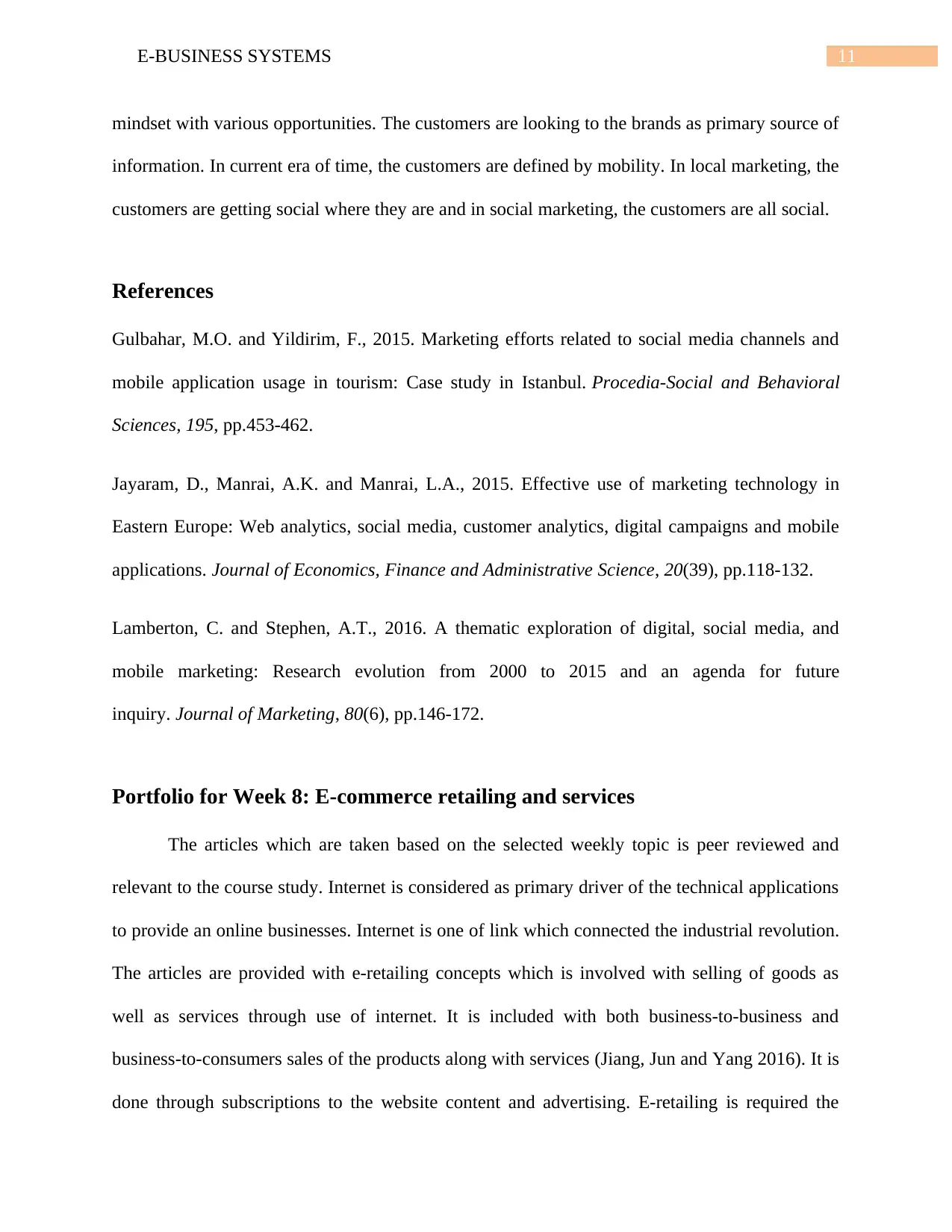
11E-BUSINESS SYSTEMS
mindset with various opportunities. The customers are looking to the brands as primary source of
information. In current era of time, the customers are defined by mobility. In local marketing, the
customers are getting social where they are and in social marketing, the customers are all social.
References
Gulbahar, M.O. and Yildirim, F., 2015. Marketing efforts related to social media channels and
mobile application usage in tourism: Case study in Istanbul. Procedia-Social and Behavioral
Sciences, 195, pp.453-462.
Jayaram, D., Manrai, A.K. and Manrai, L.A., 2015. Effective use of marketing technology in
Eastern Europe: Web analytics, social media, customer analytics, digital campaigns and mobile
applications. Journal of Economics, Finance and Administrative Science, 20(39), pp.118-132.
Lamberton, C. and Stephen, A.T., 2016. A thematic exploration of digital, social media, and
mobile marketing: Research evolution from 2000 to 2015 and an agenda for future
inquiry. Journal of Marketing, 80(6), pp.146-172.
Portfolio for Week 8: E-commerce retailing and services
The articles which are taken based on the selected weekly topic is peer reviewed and
relevant to the course study. Internet is considered as primary driver of the technical applications
to provide an online businesses. Internet is one of link which connected the industrial revolution.
The articles are provided with e-retailing concepts which is involved with selling of goods as
well as services through use of internet. It is included with both business-to-business and
business-to-consumers sales of the products along with services (Jiang, Jun and Yang 2016). It is
done through subscriptions to the website content and advertising. E-retailing is required the
mindset with various opportunities. The customers are looking to the brands as primary source of
information. In current era of time, the customers are defined by mobility. In local marketing, the
customers are getting social where they are and in social marketing, the customers are all social.
References
Gulbahar, M.O. and Yildirim, F., 2015. Marketing efforts related to social media channels and
mobile application usage in tourism: Case study in Istanbul. Procedia-Social and Behavioral
Sciences, 195, pp.453-462.
Jayaram, D., Manrai, A.K. and Manrai, L.A., 2015. Effective use of marketing technology in
Eastern Europe: Web analytics, social media, customer analytics, digital campaigns and mobile
applications. Journal of Economics, Finance and Administrative Science, 20(39), pp.118-132.
Lamberton, C. and Stephen, A.T., 2016. A thematic exploration of digital, social media, and
mobile marketing: Research evolution from 2000 to 2015 and an agenda for future
inquiry. Journal of Marketing, 80(6), pp.146-172.
Portfolio for Week 8: E-commerce retailing and services
The articles which are taken based on the selected weekly topic is peer reviewed and
relevant to the course study. Internet is considered as primary driver of the technical applications
to provide an online businesses. Internet is one of link which connected the industrial revolution.
The articles are provided with e-retailing concepts which is involved with selling of goods as
well as services through use of internet. It is included with both business-to-business and
business-to-consumers sales of the products along with services (Jiang, Jun and Yang 2016). It is
done through subscriptions to the website content and advertising. E-retailing is required the
⊘ This is a preview!⊘
Do you want full access?
Subscribe today to unlock all pages.

Trusted by 1+ million students worldwide
1 out of 14
Related Documents
Your All-in-One AI-Powered Toolkit for Academic Success.
+13062052269
info@desklib.com
Available 24*7 on WhatsApp / Email
![[object Object]](/_next/static/media/star-bottom.7253800d.svg)
Unlock your academic potential
Copyright © 2020–2025 A2Z Services. All Rights Reserved. Developed and managed by ZUCOL.





